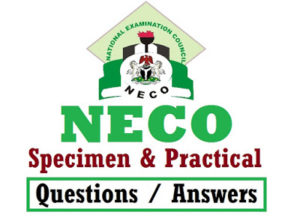NECO 2019 PRACTICAL BIOLOGY VERIFIED QUESTIONS AND ANSWER

(3ai)
Specimen M; Measuring cylinder
Specimen N; Soil sample (loamy soil)
Specimen O; Earthworm
Specimen P; Hygrometer
Specimen Q; Thermometer
Specimen R; Hand net
(3aii)
Specimen p; used in meteorological science to measure the humidity, or amount of water vapour in the air.
Specimen Q; Used for measuring temperature
Specimen R; Used for catching fish or used for hunting for fish in the river.
(3aiii)
(i)They improve the soil structure
(ii)They help to improve the fertility and nutrient content and availability in the soil
(iii)Earthworms improve soil drainage
(3bi)
(i)the soil sample settled below the water level
(ii)the water above the soil sample increase as soil goes down
(iii)the water above the soil sample get clearer
(3bii)
CLICK HERE FOR THE IMAGE
=====================================
(2ai)
SPECIMEN G: Lizard
SPECIMEN H: Snail
SPECIMEN I: Grasshopper
SPECIMEN J: Cockroach
SPECIMEN K: Orange
SPECIMEN L: Mosquito
(2aii)
Specimen G; is Reptilia
specimen H; is Gastropoda
Specimen I; is Insecta
(2bi)
Malaria
(2bii)
(i)use of insecticide
(ii)use of mosquito net
(iii)cleanliness of the environment
(2biii)
(i)The neck is short
(ii)The tail is long and tapers at the end
(2c)
CLICK HERE FOR THE IMAGE
=====================================
(1a)
SPECIMEN A: Bean seedlings (less than seven days old)
SPECIMEN B: Maize seedlings (less than seven days old)
SPECIMEN C: Coconut fruit (dry with husk)
SPECIMEN D: Tridax fruit
SPECIMEN E: Frog/Toad
SPECIMEN F: Praying Mantis
(1aii)
Specimen A; Epigeal Germination
Specimen B; Hypogeal Germination
(1aiii)
Specimen A; Because the seed coat ruptures and the embryo emerges out.
Specimen B; Because the radicle pierces through the protective sheath coleorhiza and grows downwards to form the root.
(1bi)
Specimen C ; Water
Specimen D ; Gravity
(1bii)
C – Drupe
D – Cypsela
(1ci)
Drawing of Frog: CLICK HERE FOR THE IMAGE
Drawing of Frog
(1cii)
Hindlimbs are longer than their forelimbs
(1ciii)
(i) Providing body support during sitting or walking
(ii) Pushing the body during jumps
(1d)
Specimen F
(i) Presence of two antennae
(ii) Presence of six legs
(iii) Green in colour
Specimen G
(i) Absence of antennae
(ii) Presence of four legs
(iii) black and red in colour
==================================
Completed
Categories: NECO


